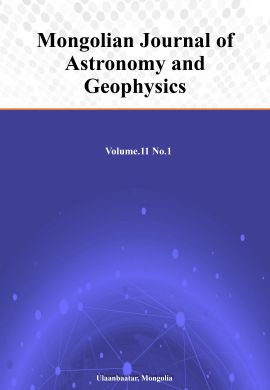Using the processing and modelling of the geomagnetic method for exploring mineral deposits: A case study at the gold area in Dashbalbar, Dornod
DOI:
https://doi.org/10.5564/mjag.v11i1.4184Keywords:
Data processing, Inversion, Anomaly, magnetic susceptibilityAbstract
This paper presents the results of geomagnetic measurements conducted along 23 profiles in the 740-hectare Uvur Khooloi area, located 35 km northwest of the centre of Dashbalbar Sum, Dornod Province. The data were processed and combined with the geological map of the area for interpretation. In this study, anomalies associated with the lithosphere were extracted from the total geomagnetic field measurements on the Earth’s surface, and an anomaly distribution map was created for the area. The magnetic anomaly map for Uvur Khooloi revealed a linear structure approximately 120 meters wide, with a high amplitude and a positive magnetic anomaly in the northeastern part of the area. Furthermore, a 2-D magnetic susceptibility distribution model across the linear structure was developed to understand the subsurface characteristics of the structure. The geological map of the area indicated that faults extending from southwest to northeast explained the geometric features of the linear structure observed in the geomagnetic field measurements. The positive geomagnetic anomalies correspond spatially with unsorted volcanic rocks and conglomerate sediments cut by short, north-south trending faults.
Downloads
201
Downloads
Published
How to Cite
Issue
Section
License
Copyright (c) 2024 Bayanjargal Gendenpuntsag, Batmagnai Erdenechimeg, Nasan-Ochir Tumen, Tserendug Shoovdor, Otgonbold Nyamdorj

This work is licensed under a Creative Commons Attribution 4.0 International License.
Copyright on any research article in the Mongolian Journal of Astronomy and Geophysics is retained by the author(s).
The authors grant the Mongolian Journal of Astronomy and Geophysics a license to publish the article and identify itself as the original publisher.

Articles in the Mongolian Journal of Astronomy and Geophysics are Open Access articles published under a Creative Commons Attribution 4.0 International License CC BY.
This license permits use, distribution and reproduction in any medium, provided the original work is properly cited.




